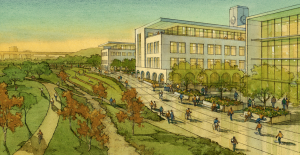SDSU Unveils Expansion Plan
San Diego State University showcased “SDSU Mission Valley,” their detailed vision and plan for the 166 acres of land which include and surround SDCCU Stadium.
“San Diego State University has grown exponentially from our humble beginnings 120 years ago to a national research university of 36,000 students enrolled in bachelor’s, master’s, and doctoral programs. Today, SDSU produces leaders in every profession,” said Sally Roush, San Diego State University President, in a newsletter. “SDSU is one of the top economic generators for the San Diego region.”
According to a recent analysis by ICF, an international consulting firm specializing in economic impact studies, the university generates $5.67 billion in economic activity, and $457 million in state and local tax revenues each year.
“To meet increasing demands for quality space to support academic and research needs, to support current and future students, and to continue contributing to the regional economy, SDSU must identify opportunities for expansion. The San Diego campus is landlocked on 288 acres,” Roush said.
This past July, the university announced that SDSU would embark on a vision and site plan for a large amount of acreage in Mission Valley – most commonly referred to as “the Mission Valley site.”
The plan features architectural renderings by Carrier Johnson + CULTURE.
According to the university, SDSU is able to purchase the land at fair market value and finance the construction, should it have the opportunity to do so. The plan does not rely on taxpayer dollars.
SDSU Mission Valley will provide housing for upper-division and graduate-level students, faculty and staff, along with work-force and affordable housing; a new multi use stadium for collegiate athletics, professional sports, and other entertainment events; commercial office buildings to include innovation and research space. It also includes space for a 250-room conference center hotel.
The site plan also features community parks, open space, and recreation fields, accounting for more than 50 percent of the site.
“The Mission Valley site represents a once-in-a-generation opportunity for SDSU to design and implement a campus plan that optimally accommodates the educational needs of our future students and ensures the continued viability of SDSU’s higher education mission,” Roush said.


 Ana Gomez Salcido
Ana Gomez Salcido




